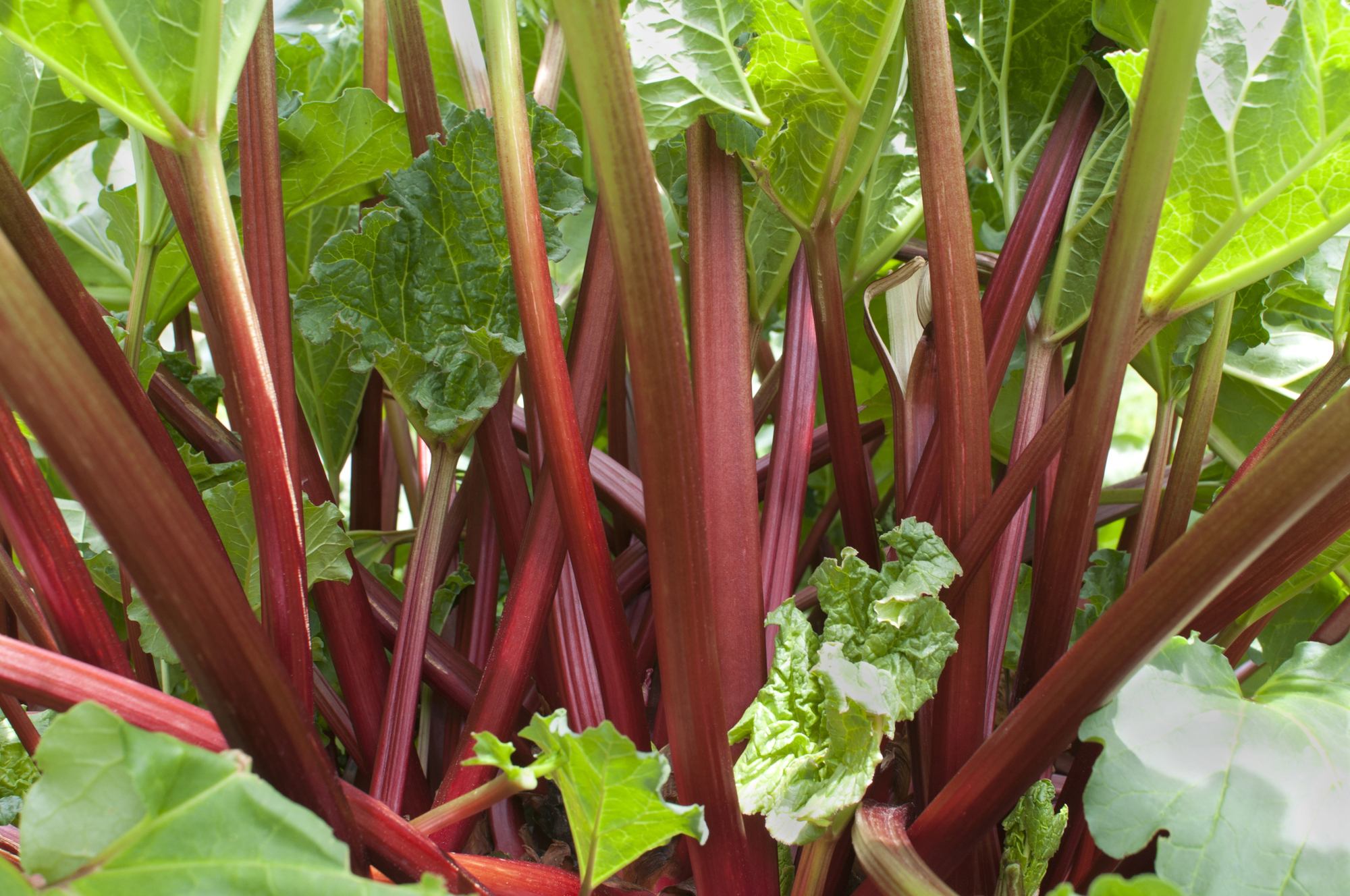Rhubarb Donation Tracker
Quick Links: How & Where to Grow | Temperature | How to Care For | Harvest Signs | Harvesting | Pests | Companions | Varieties | Preservation | Recipes | Michigan Tips | Fun Facts
🌱 How & Where to Grow Rhubarb:
- Plant crowns in early spring as soon as soil can be worked.
- Choose permanent location – rhubarb can produce for 15-20 years!
- Space plants 3-4 feet apart – they grow into large clumps.
- Plant crowns with buds 1-2 inches below soil surface.
- Sunlight: Full sun to partial shade (6+ hours preferred).
- Soil Type: Rich, well-drained soil with pH 6.0-6.8.
- Soil Amendment: Heavy feeder – add generous compost and aged manure.
Patience required: No harvest year 1, light harvest year 2, full harvest year 3 onward!
🌡️ Temperature Guidance:
Needs 500+ hours below 40°F. Hardy to -40°F. Dies back at frost.
- Winter chill: Requires extended cold for proper dormancy.
- Spring growth: Begins when soil reaches 40°F.
- Growing season: Thrives at 60-75°F.
- Summer stress: Goes semi-dormant above 85°F.
- Extremely cold hardy – one of the first plants up in spring!
Michigan’s cold winters are essential – rhubarb won’t grow in warm climates!
💧 How to Care for:
- Consistent Moisture: Critical for tender stalks – never let dry out.
- Watering: 1-2 inches weekly, more during stalk production.
- Mulch: 3-4 inches of organic mulch, pull back in early spring.
- Fertilizer: Top-dress with compost each spring, side-dress after harvest.
- Flower removal: Cut flower stalks immediately to maintain production.
📏 Harvest Signs:
No harvest year 1, light year 2, full year 3+. Stalks 12-18 inches long.
- Year 1: NO harvesting – let plant establish.
- Year 2: Harvest lightly for 2-3 weeks only.
- Year 3+: Full harvest for 8-10 weeks in spring/early summer.
- Stalk readiness: 12-18 inches long, at least 3/4 inch thick.
- Stop harvesting: By July 4th to let plant recover for next year.
Color doesn’t indicate ripeness – some varieties stay green when ready!
🧺 Harvesting:
Pull stalks with twist. Never harvest more than 1/3. Leaves toxic!
- Grasp stalk near base and pull with slight twisting motion.
- Alternative: Cut with sharp knife at soil level.
- Remove leaves immediately – they’re TOXIC to humans and animals!
- Harvest rule: Never take more than 1/3 of stalks at once.
- Leave small stalks (pencil-thin) to feed the plant.
🪲 Michigan Pests:
Remarkably pest-free! Occasional crown rot, rhubarb curculio.
- Crown rot: Main problem in poorly drained soil – ensure good drainage.
- Rhubarb curculio: Beetle that punctures stalks – hand-pick if seen.
- Slugs: May damage young shoots – use beer traps.
- Leaf spots: Remove affected leaves, improve air circulation.
- Generally one of the most trouble-free perennial crops!
🫱🏽🫲🏼 Companions:
Good with garlic, onions, beans. Give plenty of space – grows large!
- Garlic and onions: May help deter pests.
- Beans: Fix nitrogen that benefits hungry rhubarb.
- Avoid: Competition from trees or large shrubs.
- Space consideration: Mature plants spread 4+ feet wide.
- Permanent bed: Best grown with other perennials like asparagus.
🌿 Varieties:
‘Victoria’, ‘Canada Red’, ‘Valentine’, ‘Crimson Cherry’.
- ‘Victoria’: Green stalks, reliable, good for Michigan.
- ‘Canada Red’: Deep red stalks, sweet, cold hardy.
- ‘Valentine’: Red stalks, less stringy, excellent flavor.
- ‘Crimson Cherry’: Bright red, sweet, low acid.
- ‘MacDonald’: Tender red stalks, Canadian variety.
🫙 Preservation:
Freeze raw chunks. Can as sauce. Dehydrate. Fresh 1 week.
- Freezing: Cut in 1-inch pieces, freeze on trays, bag when solid.
- Fresh storage: Wrap stalks in damp towel, refrigerate 1 week.
- Canning: Only as sauce or jam – follow tested recipes.
- Dehydrating: Makes tart “fruit” leather.
- Root cellar: Dig roots in fall, force indoors for winter stalks.
🧑🏽🍳 Recipes:
Strawberry-rhubarb pie, rhubarb crisp, compote, chutney, upside-down cake.
- Classic strawberry-rhubarb pie – the perfect spring dessert!
- Rhubarb crisp with oatmeal topping.
- Rhubarb simple syrup for cocktails and lemonade.
- Savory rhubarb chutney for meats.
- Rhubarb barbecue sauce – surprisingly delicious!
✋🏼 Michigan Tips:
- Michigan’s climate is perfect – we easily meet chill requirements.
- Divide established clumps every 6-8 years in early spring.
- Sterling Heights area was once the “Rhubarb Capital” of the U.S.!
- Apply winter mulch after ground freezes.
- Force early stalks by covering with buckets in March.
- Plant on north side of garden – won’t shade other crops.
🧠 Fun Facts:
- Actually a vegetable but legally classified as fruit in the U.S. (1947 court case)!
- Native to Siberia – needs cold winters to thrive.
- Leaves contain toxic oxalic acid but make great organic pesticide.
- Michigan once produced 90% of the world’s hothouse rhubarb.
- Marco Polo introduced rhubarb to Europe from China.
- Originally grown for medicinal purposes, not food.
- The word comes from Greek “rha” (Volga River) and “barbarum” (foreign).
- Forcing rhubarb in dark cellars produces tender, sweet “champagne” rhubarb.


0 Comments